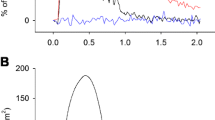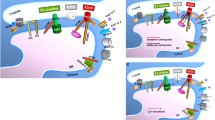Abstract
Laser scanning confocal imaging was used to monitor release of Ca2+ from localized regions in a skeletal muscle cell line with sparsely distributed Ca2+ release sites. The goal was to distinguish between two schemes proposed to explain the phenomenon of “quantal” Ca2+ release from caffeine-sensitive Ca2+ stores in muscle and other tissues: (1) all-or-none (true quantal) Ca2+ release from functionally discrete stores that have different sensitivities to caffeine; or (2) adaptive behavior of individual release sites, each responding transiently and repeatedly to incremental caffeine doses. Our results showed that Ca2+ release induced by K+ or caffeine occurs in discrete loci within the cell. The image areas and fluorescence intensities of some of these evoked local signals were similar to those of Ca2+ sparks that were observed under resting conditions and which are believed to be due to spontaneous activation of single release units. In contrast to the expectations imposed by quantal models, incremental doses of caffeine activated the same sets of release sites throughout the cell. Ca2+ release, at a given site, triggered by a submaximal dose of caffeine was transient and could be reactivated by addition of a higher caffeine dose, showing the same type of adaptive behavior as measured globally from larger areas of the cell. These results suggest that incremental Ca2+ release is accounted for by adaptive behavior of individual Ca2+ release sites.
Similar content being viewed by others
References
Cannel MB, Cheng H, Lederer WJ (1994) Spatial non-uniformities in [Ca2+]i during excitation-contraction coupling in cardiac myocytes. Biophys J 67:1942–1956
Cheek TR, Moreton RB, Berridge MJ, Staunderman KA, Murawsky MH, Bootman MD (1993) Quantal Ca2+ release from caffeine-sensitive stores in adrenal chromaffin cells. J Biol Chem 288:27076–27083
Cheek TR, Berridge MJ, Moreton RB, Staunderman KA, Murawsky MH, Bootman MD (1994) Quantal Ca2+ mobilization by ryanodine receptors is due to all-or-none release from functionally discrete intracellular stores. Biochem J 301:879–833
Cheng H, Cannel MB, Lederer WJ (1994) Calcium sparks: elementary events underlying excitation-contraction coupling in heart muscle. Science 262:740–744.
Cleemann L, Morad M (1991) Role of Ca2+ channel in cardiac excitation-contraction coupling in the rat: evidence from Ca2+ transients and contraction. J Physiol (Lond) 432:283–312
Dettbarn C, Györke S, Palade P (1994) Many agonists induce “quantal” Ca2+ release or adaptive behavior in muscle ryanodine receptors. Mol Pharmacol 46:502–507
Ezerman EB, Ishikava H (1967) Differentiation of the sarcoplasmic reticulum and T system in developing chick skeletal muscle in vivo. J Cell Biol 35:405–420
Fabiato A (1985) Time and calcium dependence of activation and inactivation of calcium-induced calcium release from the sarcoplasmic reticulum of a skinned canine cardiac purkinje cell. J Gen Physiol 85:247–289
Franzini-Armstrong C (1991) Simultaneous maturation of transverse T tubules and sarcoplasmic reticulum during muscle differentiation in the mouse. Dev Biol 46:353–363
Györke S, Fill M (1993) Ryanodine receptor adaptation: control mechanism of Ca2+-induced Ca2+ release in heart. Science 260:807–809
Györke S, Fill M (1994) Ca2+-induced Ca2+ release in response to flash photolysis. Science 263:987–988
Györke S, Palade P (1994) Ca2+-dependent negative control mechanism for Ca2+-induced Ca2+ release in crayfish muscle. J Physiol (Lond) 476:315–322
Györke S, Velez P, Suarez-Isla B, Fill M (1994) Activation of single cardiac and skeletal ryanodine receptors by flash photolysis of caged Ca2+. Biophys J 66:1879–1886
Kovach L, Rios E, Schneider MF (1979) Calcium transients and intramembrane charge movement in skeletal muscle fibers. Nature 279:391–396
Lamb GD, Fryer MW, Stephenson DG (1994) Ca2+-induced Ca2+ release in response to flash photolysis. Science 263: 986–987
Melzer W, Hermann-Frank A, Luttgau HC (1995) The role of Ca2+ ions in excitation-contraction coupling of skeletal muscle fibres. Biochim Biophys Acta 1241:59–116
Niggli E, Hadley RW, Kirby MS, Lederer WJ (1993) Real-time fluorescence microscopy in living cells. In: Herman B, Lemasters JJ (eds) Optical microscopy. Academic Press, New York, pp 213–233
Parker I, Yao Y (1991) Regenerative release of calcium from functionally discrete subcellular stores by inositol trisphosphate. Proc R Soc Lond [Bio] 246:269–274
Petersen OH, Petersen CCH, Kasai H (1994) Calcium and hormone action. Annu Rev Physiol 56:297–319
Rios E (1994) Reining in calcium release. Biophys J 67:7–9
Rios E, Pizarro G (1991) Voltage sensor of excitation-contraction coupling in skeletal muscle. Physiol Rev 71:849–908
Schneider MF, Simon B (1988) Inactivation of calcium release from the sarcoplasmic reticulum in frog skeletal muscle. J Physiol (Lond) 405:727–745
Short AD, Klein MG, Schneider MF, Gill D (1993) Inositol 1,4,5-trisphosphate-mediated quantal Ca2+ release measured by high resolution imaging of Ca2+ within organelles. J Biol Chem 268:25887–25893
Stern MD, Lakatta E (1992) Excitation-contraction in the heart: the state of the question. FASEB J 6:3092–3100
Taylor CW, Richardson A (1993) Structure and function of inositol trisphosphate receptors. In: Taylor CWT (ed) Intracellular messengers. Pergamon, Oxford, York, pp 199–254
Teresaki M, Reese T (1992) Characterization of endoplasmic reticulum by co-localization of BIP and dicarbocyonine dyes. J Cell Sci 101:315–322
Valdivia H, Kaplan JH, Ellies-Devies GCR, Lederer WJ (1995) Rapid adaptation of cardiac ryanodine receptors: modulation by Mg2+ and phosphorylation. Science 267:1997–2000
Yaffe D, Saxel O (1977) Serial passaging and differentiation of myogenic cells isolated from dystrophic mouse muscle. Nature 270:725–727
Yasui K, Palade P. Györke S (1994) Negative control mechanism with features of adaptation controls Ca2+ release in cardiac myocytes. Biophys J 67:457–460
Author information
Authors and Affiliations
Rights and permissions
About this article
Cite this article
Györke, I., Györke, S. Adaptive control of intracellular Ca2+ release in C2C12 mouse myotubes. Pflügers Arch. 431, 838–843 (1996). https://doi.org/10.1007/s004240050075
Received:
Accepted:
Issue Date:
DOI: https://doi.org/10.1007/s004240050075




